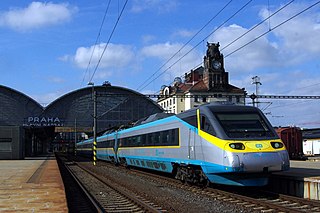Transport in Angola comprises:

This article is about transport in Belarus.

Bosnia and Herzegovina has facilities for road, rail and air transport. There are five international road routes and 20 state highways, with bus connections to many countries. Railways total just over 1,000 km with links to Croatia and Serbia. There are 25 airports, seven of them with paved runways. The Sava River is navigable, but its use is limited.

This article provides a breakdown of the transportation options available in Cameroon. These options are available to citizens and tourists such as railways, roadways, waterways, pipelines, and airlines. These avenues of transport are used by citizens for personal transportation, of goods, and by tourists for both accessing the country and traveling.

Transport in the Czech Republic relies on several main modes, including transport by road, rail, water and air.
Transportation in Ecuador is the transport infrastructure networks in Ecuador and those connecting the country with other countries. Transportation in Ecuador include aviation, highways, pipelines, ports and harbors, railways and waterways. Apart from transporting passengers, the country is a relatively small exporter of fruits and vegetables such as banana, papayas and pineapples.

El Salvador has transport links by road, rail, sea and air.
Modes of transport in Fiji include rail, road, water, and air. The rail network is mainly used for movement of sugar cane. Suva and Lautoka are the largest seaports. There are 122 km of navigable inland waterways. There are two international airports, one other paved airport, and over 20 with unpaved runways. With 333 tropical islands that make up this country, one can expect to use various modes of transport to get to their destination.
Modes of transport in Gabon include rail, road, water, and air. The one rail link, the Trans-Gabon Railway, connects the port of Owendo with the inland town of Franceville. While most of the country is connected by roads, not all areas are accessible. Much of the road network remains unpaved, and it primarily revolves around seven "national routes" labeled N1 through N7. The largest seaports are Port-Gentil and the newer Owendo, and 1,600 km of inland waterways are navigable. There are three international airports, eight other paved airports, and over 40 with unpaved runways. Nearly 300 km of pipelines carry petroleum products, mainly crude oil.
For Soviet transportation, see Transport in the Soviet Union.
Transport in Grenada consists of a network of highways connecting major population centres, airports and ports and harbours along the coast. Grenada has no merchant marine.
Transportation in Guatemala includes roads, waterways, airports and a short cross-border rail line from Mexico.
This article provides an overview of the transport infrastructure of Latvia.

Railways: 0 km
Transportation in the country of Togo is by road, rail, water or air.
The transport network in Uruguay consists of 1,673 km of rail network, 7,743 km of paved roads, 1,600 km of navigable waterways, and 11 airports with paved roads.

Vanuatu's undeveloped road system, with fewer than 100 miles of paved roads, consists mostly of dirt tracks suitable only for four-wheel-drive vehicles. Every island has one or two short airstrips where Vanair’s Twin Otter planes land two or three times weekly. In addition, every island has a small port or wharf where small cargo ships and boats regularly dock.
Transport in Belize mostly consists of bus transportation on Belize's roads. There are some navigable waterways.







